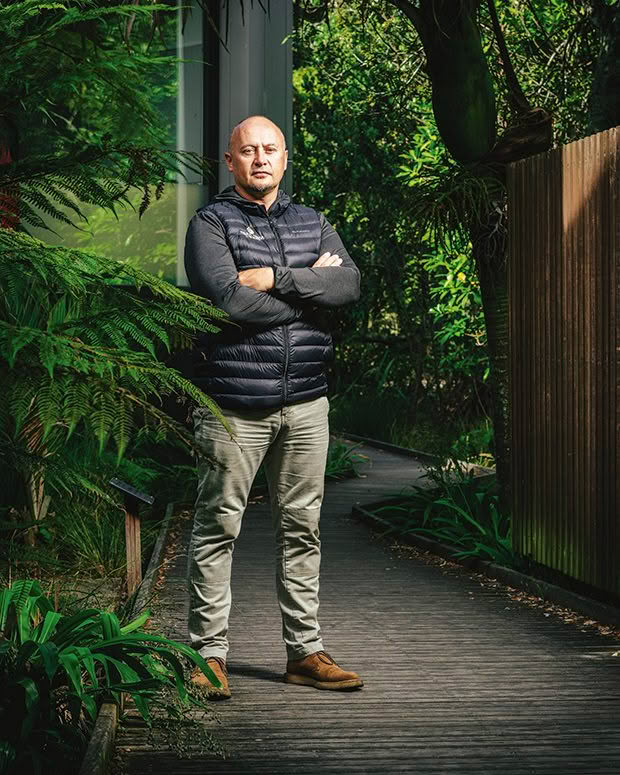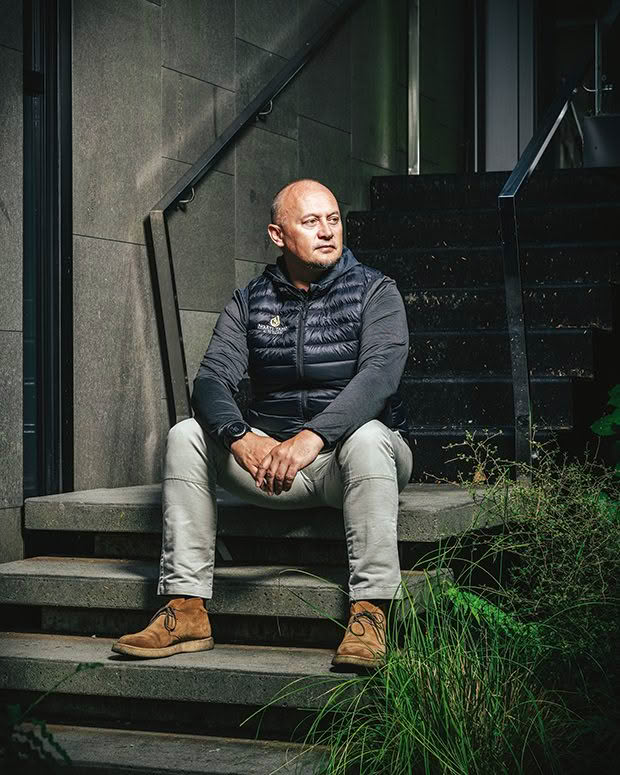A man’s journey to leadership through reconnecting to his roots

Despite growing up in the vibrant Māori communities of Paraparaumu and Waikanae, Hemi Sundgren felt disconnected from his ancestral land and language. His quest to reclaim identity and te reo Māori has put him in the roles of historian, artist and tribal leader.
Words: Amokura Panoho Photos: Daniel Allen
PEPEHA
Mai i Waitapu ki Rangataua, mai i Miria te Kakara ki Whitireia
Whakawhitia te moana o Raukawa ki Wairau ki Whakatū
Ko Ngāti Raukawa, Ko Ngāti Toa, Ko Ngāti Koata, Ko Ātiawa ki Whakarongotai ngā iwi
Ko Tararua te pae maunga, Ko Kāpiti te motu, Ko Te Rau o te rangi te moana.
From Waitapu to Rangataua and Miria te kakara in the Rangitīkei region to Whitireia in Porirua,
Stretching across the Raukawa strait to the Wairau and Nelson regions
A descendant of Ngāti Raukawa, Ngāti Toa, Ngāti Koata and Ātiawa ki Whakarongotai
Tararua is the great mountain divide, Kāpiti Island stands offshore, separated by the waters of Te Rau o te Rangi channel.
Hemi Sundgren has held executive leadership positions with Te Rūnanga o Ngāti Mutunga, Te Kāhui o Taranaki, Te Kotahitanga o Te Ātiawa, and currently serves as the chief executive of Ngāti Tama ki Te Tauihu in Nelson. He is also a director for Taranaki Mounga and the family-owned enterprise, Whiri. During 2020-2022, he was the pou arahi (national Māori manager) for Tourism New Zealand.
WHAT HAVE YOU LEARNT AND FROM WHOM?
My mother, Sherrin, daughter of Pataka Webster and Joan Winterburn, has strong whakapapa connections to the Kāpiti Coast. My father Paul, a Pākehā, born and raised in the strong Māori community of Waikanae, was immersed in mahi kai (growing food on the land), as his father Snow Sundgren’s well-known market garden was where many whānau worked.
I was born and raised in Waikanae and Paraparaumu, and my parents were deeply involved in the club culture of rugby league, rugby, netball, wrestling and the Whakarongotai Marae. My values, including the importance of providing for whānau, were set early in life with a fantastic upbringing. My earliest recollections revolve around communities of service and giving back, contributing and supporting each other in times of need.
Waikanae was like a train station with Taranaki, Ōtaki, Porirua, Pōneke (Wellington) and even Te Tauihu (top of the South Island) whānau calling into the marae to visit relations. A natural consequence of pre-colonisation travel by iwi back and forth between Taranaki, Wellington and Te Tauihu is the many descendants settling around Waikanae.
My mother’s brother Pat Webster managed a sheep and beef farm at the top end of the Waitōtara Valley. He was hardworking, and when I could, I’d join him and the whānau to help with fencing, mustering and general stock work. In our spare time, we were taken hunting, fishing (for tuna) and mahi kai.
I still felt a big gap around the deeper aspects of our culture; the arts and the language.
HOW DID YOUR LEADERSHIP EVOLVE?
My grandfather’s brother Kohe Webster was a master carver who influenced the Māori arts scene. But, he was not an active reo speaker, and I wondered why our family had no native speakers. This inspired me to reclaim those things and develop a passion for our language.
My grand-uncle Kohe had a relationship with Te Miringa Hohaia, a tribal leader based at Parihaka in Taranaki, whom I approached to become a mentor. I was fortunate to spend extended periods of time with him and his whānau.
He had a profound impact on me over the next 20 years, and I was exposed to pūrākau (historical narratives), karakia (traditional chants/prayers), mai rākau (traditional martial arts) and, by default, the subsequent impact of colonisation. He served his community with a very deep knowledge of the cultural nuances I had a hunger for.
For me, he brought the deeper aspects of our cultural taonga (treasures) and kōrero into view, which led me to dive deeper into tribal histories. This foundation allowed me to support some of our iwi in Taranaki on their treaty claims during the early 2000s until a few years ago.
Other mentors, such as Dr Huirangi Waikerepuru and Dr Ruakere Hond, would later provide advice and support in understanding the deeper aspects of our historical context.
In the 1990s, I did a three-year carving apprenticeship at the Māori arts and crafts institute, Te Puia in Rotorua, and later became a tā moko artist (tattooist). Artistic disciplines have been fundamental for senior leadership roles with iwi. It is a creative mindset used for finding solutions to challenges. At carving school, our mantra was not to make mistakes but adjustments. It can be hard to navigate the complex situations of our iwi, hapū and whānau, so a creative mindset can be valuable. This knowledge provides the foundation for those in leadership positions to bring forth for the younger generation and their understanding of who they are. My journey is about leading them to their identity through whakapapa (genealogy), karakia, the arts and deeper aspects of our culture.
WHAT ARE YOUR GOALS?
When the role of chief executive for Ngāti Tama ki te Waipounamu came up, it was an aligning of the stars. My partner Keri’s parents are getting older, and she’d spent 25 years with me in Waikanae, Rotorua, then Taranaki, so it was time to respect that and honour her and our tamariki wanting to spend more time with her whānau here.
I feel a sense of familiarity with Ngāti Tama, the sense of cultural loss that Te Tauihu had experienced through their loss of land and the layers of colonisation. Ngāti Tama are on their own cultural reclamation journey, and I feel privileged to be able to provide some support and leadership.

HOW WILL THESE ASPIRATIONS BE ACHIEVED?
Leveraging our economic strengths in property, aquaculture, horticulture, forestry and agriculture — our biggest commercial asset bases. But, of course, the commercial and economic drivers are primarily there to support, empower and lead a deeper social, cultural and environmental agenda while providing opportunities for our people to become involved and reconnected.
However, very complex layers of interest with different iwi having various rights means one of the biggest challenges is leveraging each other’s strengths and opportunities to collectivise. If we can learn from other regions like Taranaki with their recent efforts (related to common interests in their maunga/mountain) and turn outward when we need to, then when necessary collaborate on strategic matters, it will give opportunity for greater things. Or, at the least, provide a platform for future development.
Our biggest ongoing challenge at Te Tauihu is understanding and finding the balance between kotahitanga (unity) while respecting mana motuhake (self-management) and rangatiratanga (authority) that lie in its respective component parts.
THOUGHTS ON THE POST-SETTLEMENT ENVIRONMENT AND ITS CHALLENGES
I think the Crown constantly pushes us into this construct of drawing lines in the sand, but in Tauihu, you can’t draw lines because of the complex layers of interest. All the iwi in this region have a connection; everyone has a layer of interest.
Everyone believes they have rights on the back of that interest, so I don’t believe you can say, “Well, you’re here, and you’re there, and it’s our space.” That just leads to conflict.
Another challenge is to reconnect our people living outside of our current rohe (region) and inspire them to understand a little bit more about who they want to be as Ngāti Tama.
Among our Māori community, we’re also competing against the other members’ whakapapa, perhaps with Te Ātiawa, Ngāti Rārua, Ngāti Kōata, Ngāti Toa or the Kurahaupō tribes, who, like us, are also trying to draw from them their time, energy and effort. It’s a unique and complex challenge as we are the smallest iwi in this region and competing — unintentionally, of course — against ourselves or our cousins across the street. How are we relevant and attractive to our young people in a way that makes them want to be a part of us and understand more about themselves?
YOUR ADVICE FOR READERS?
Understand a little bit more about who we are. Don’t be afraid to engage in a conversation. Some of the greatest kaupapa have started over a cup of tea — or coffee. We want the opportunity to participate in building a better community here. If that begins with a drink, that’s fantastic. We are serious about our responsibility to contribute to what makes Te Tauihu a better place for our people to come to live, work and play.
NGĀTI TAMA
The area of interest for Ngāti Tama is primarily around the Whangamoa Range and Rai Saddle, extending across Tasman Bay, Abel Tasman National Park and Golden Bay, and over into the west coast to Kahurangi Lighthouse. It is a large area.
In about 1820, an alliance of Tainui and Taranaki tribes, including some Ngāti Tama under their paramount chief Te Pūoho ki te Rangi, participated in a raid to Te Upoko o Te Ika (southern North Island). By the mid-1820s, these tribes had established themselves at Kāpiti Island and on the mainland east and south to Cook Strait. Relationships based on trade, service provision and marriage were established with whalers.
Eventually, the Tainui and Taranaki alliance crossed the Cook Strait to Te Tauihu o te Waka a Māui. Te Pūoho ki Te Rangi, other Ngāti Tama chiefs, and rangatira from other iwi led the conquest of western Te Tauihu. After the conquest, members of the Tainui and Taranaki alliance, including Ngāti Tama, established permanent communities in the northern South Island.
Ngāti Tama ki Te Waipounamu Trust is a private trust. It owns, manages and administers the Ngāti Tama Te Tauihu-based settlement assets for the benefit of Ngāti Tama iwi. It is also the mandated body to receive the assets from the Ngāti Tama historical Treaty of Waitangi settlement.
The financial position of the trust as of 11 December 2023 was about $77 million.
Love this story? Subscribe now!
 This article first appeared in NZ Life & Leisure Magazine.
This article first appeared in NZ Life & Leisure Magazine.
